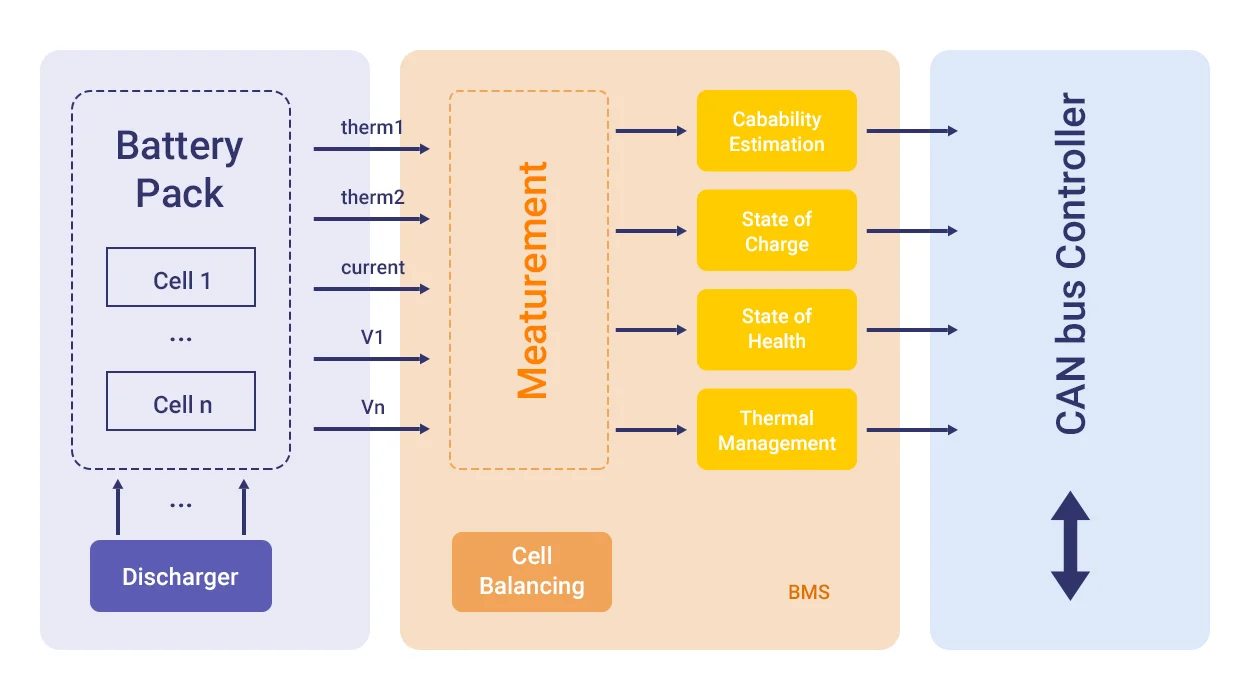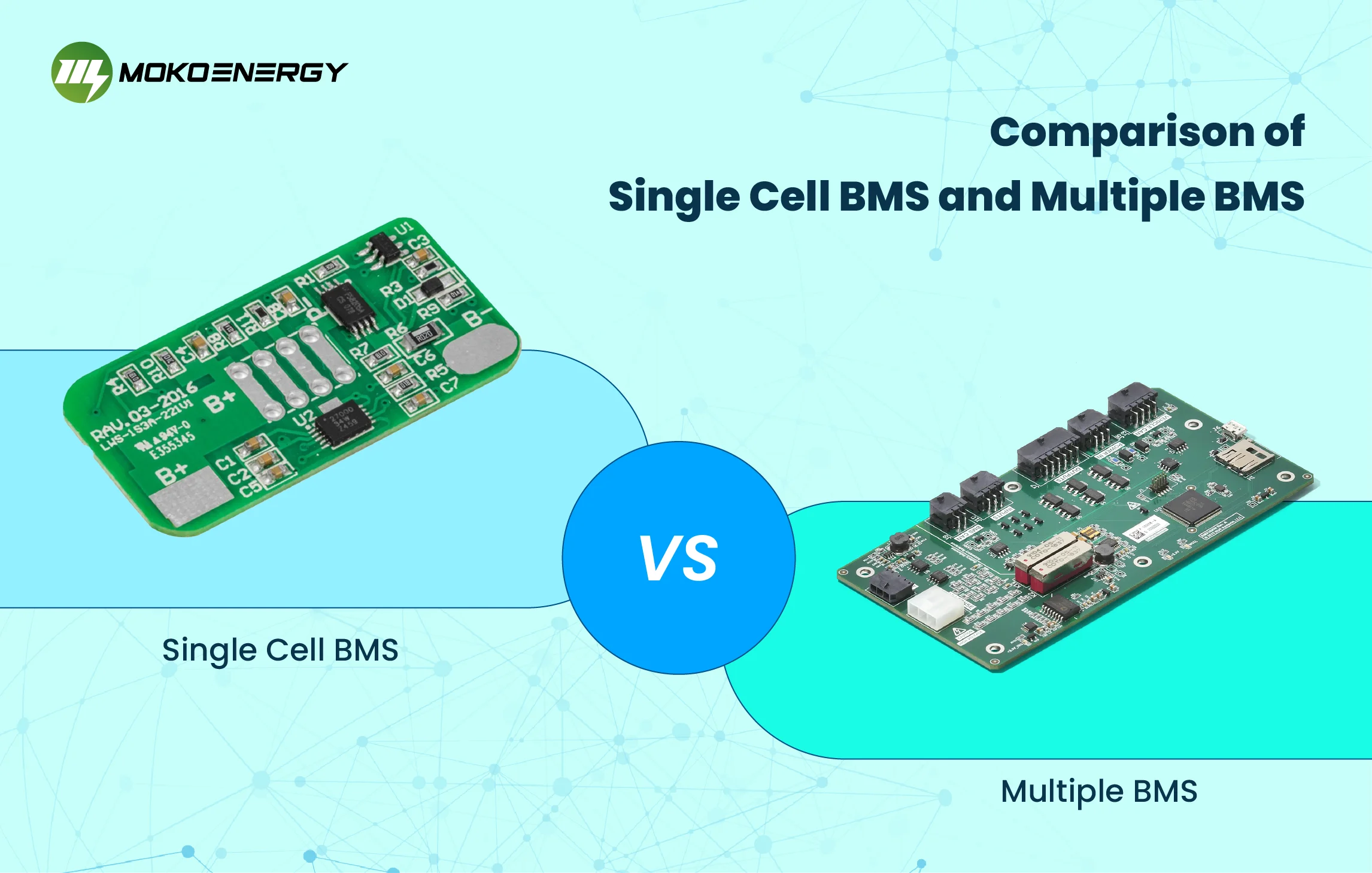In today’s fast-paced world, batteries power an extensive array of applications, from mobile devices and electric vehicles to renewable energy storage systems. The efficient and safe operation of batteries is crucial for enhancing overall performance, extending battery life, and ensuring user safety. The Battery Management System (BMS) emerges as the linchpin that revolutionizes the way we harness the potential of batteries across diverse industries. The battery management system architecture is a sophisticated electronic system designed to monitor, manage, and protect batteries. It acts as a vigilant overseer, constantly assessing essential battery parameters like voltage, current, and temperature to enhance battery performance and guarantee safety. This article explores the fundamental components, various architectural configurations, and advanced features of the BMS that drive its significance in the battery ecosystem.
Basic Components of Battery Management System Architecture
- Battery Management System Architecture diagram
Before we delve into a comprehensive explanation of the battery management system architecture, let’s first examine the battery management system architecture diagram. By referring to the BMS architecture diagram, we can gain a basic understanding of the overall structure.

The architecture is a systematically thought-out and well-balanced decision, under the constraints of existing resources, resulting in a clear system framework: including subsystems, modules, components, their constraints, and guiding principles. Now, let’s take a closer look at the architecture of the battery management system design.
- Battery Management System Subsystem Overview
- Battery Monitoring Subsystem: This subsystem is responsible for the real-time monitoring of individual battery cells or cell groups. It measures critical parameters like voltage, current, temperature, and state-of-charge (SOC) to provide crucial data for battery management and protection.
- Cell Balancing Subsystem: The cell balancing subsystem aims to maintain uniform charge and discharge levels among battery cells in a pack. It equalizes the SOC across cells to prevent capacity mismatch and enhance overall battery performance.
- Battery Protection Subsystem: Ensuring the safety of the battery is the primary function of this subsystem. It prevents overcharging, over-discharging, and thermal runaway by implementing safety mechanisms like voltage and temperature monitoring, short circuit protection, and current limiting.
- Communication and Control Subsystem: This subsystem facilitates communication and data exchange between various BMS components, ensuring seamless coordination and control of battery operations.
- Battery Management System Architecture Modules
- Battery Monitoring Module: This module houses sensors and circuitry responsible for measuring the voltage, current, and temperature of individual battery cells or cell groups. It collects information and transmits it to the control module for further analysis.
- Control Module: The control module processes the data received from the battery monitoring module and formulates control strategies for charging, discharging, and cell balancing. It acts as the brain of the BMS.
- Protection Module: The protection module consists of electronic components that oversee the battery’s voltage, temperature, and various other parameters. If any abnormal conditions are detected, it triggers protective measures to ensure battery safety.
- Communication Module: The communication module provides the interface for data exchange with other BMS modules and external systems. It facilitates seamless communication between subsystems for coordinated operation.
- Battery Management System Architecture Components
Battery Monitoring Unit (BMU)
The Battery Monitoring Unit (BMU) plays a crucial role in the BMS architecture by continuously measuring essential battery parameters such as voltage, current, temperature, state of charge (SOC), and state of health (SOH). As the vigilant eyes and ears of the BMS, the BMU ensures real-time monitoring of the battery’s condition and performance.
Accurate data collection by the BMU is of paramount importance for effective battery management. Precise measurement of voltage, current, and temperature allows the BMS to make informed decisions regarding charging, discharging, and cell balancing. The BMS can enhance battery performance, prolong battery lifespan, and ensure the safety and efficiency of battery operation through precise data utilization.
Cell Balancing Circuitry
Cell balancing is a critical function in the architecture of battery management system that ensures equal charge and discharge distribution among battery cells. In a battery pack with multiple cells, variations in cell characteristics may lead to imbalances, reducing overall battery efficiency and lifespan. Cell balancing circuitry steps in to rectify these imbalances and ensure uniform energy distribution among cells.
The BMS utilizes various cell balancing methods, including passive, active, and hybrid approaches. Passive balancing involves the use of resistor networks to release surplus energy from cells with higher voltage levels. Active balancing utilizes active switches to redistribute energy among cells actively. Hybrid balancing combines passive and active techniques for a balanced and efficient approach. The selection of the cell balancing technique relies on the particular needs of the battery pack and the performance objectives.
Battery Protection Circuitry
Battery protection circuitry is a critical component that ensures the safety and reliability of the battery. It guards against potential hazards such as overcharging, over-discharging, and thermal runaway, which can lead to irreversible damage or pose serious safety risks.
The battery protection circuitry constantly observes the battery’s voltage, temperature, and other factors. If it identifies any irregularities, it activates safety measures to protect the battery. Safety features such as voltage and temperature monitoring, as well as short circuit protection, are essential to prevent catastrophic failures and maintain the integrity of the battery system.
Communication Interface
The communication interface is a pivotal aspect of BMS architecture, enabling seamless data exchange and system integration. It allows different BMS components, including the BMU, cell balancing circuitry, and protection circuitry, to communicate with each other and exchange critical information.
Different communication protocols, including CAN (Controller Area Network), SMBus (System Management Bus), and RS485, are employed in BMS architecture. These protocols ensure efficient and reliable data transfer between components, enabling real-time monitoring, analysis, and coordinated control of the battery system.
- Battery Management System Architecture Constraints and Guidelines
The design of BMS must comply with relevant safety regulations and standards, such as ISO 26262 (automotive safety standard) and IEC 62619 (energy storage system standard), among others.
Battery Management System BMS needs to meet the specific requirements of particular applications, such as electric vehicles, consumer electronics, or energy storage systems. When designing the BMS, these constraints and guidelines must be taken into consideration.
In conclusion, building a battery management system architecture needs various subsystems, modules, and components working together to ensure efficient battery monitoring, management, and protection. By adhering to safety, efficiency, scalability, reliability, interoperability, and flexibility guidelines, BMS designs can cater to diverse battery applications and optimize overall battery performance.
Battery Management System Architectural Configurations
Centralized Battery Management System Architecture
Centralized battery management system architecture involves integrating all BMS functions into a single unit, typically located in a centralized control room. This approach offers a streamlined and straightforward design, where all components and functionalities are consolidated into a cohesive system.
Advantages:
- Simplicity: The centralized architecture is relatively simple to implement and manage, as all components are housed in one location.
- Cost-Effective: Centralized BMS solutions may be cost-effective for smaller-scale applications, as they require fewer communication interfaces and reduced battery management system hardware architecture complexity.
- Real-Time Monitoring: Centralized BMS provides centralized real-time monitoring of battery performance and health, facilitating prompt decision-making and efficient control.
Limitations:
- Single Point of Failure: The centralized architecture is vulnerable to a single point of failure. If the central unit malfunctions, it can lead to system-wide issues and potential downtime.
- Communication Overhead: The need for extensive cabling to connect the central unit to distributed battery modules can result in communication overhead and increased complexity.
Distributed Battery Management System Architecture
In a distributed battery management system architecture, various BMS functions are distributed across multiple units or modules that are dispersed throughout the battery system. Each module is responsible for specific tasks and communicates with other modules and the central controller.
Benefits:
- Redundancy: Distributed BMS provides a higher level of redundancy. In the event of a module failure, the system can maintain its operation with the remaining operational modules, thereby increasing the system’s reliability.
- Scalability: Distributed BMS allows for greater scalability as additional battery modules can be easily added without affecting the overall system architecture.
- Reduced Communication Overhead: Distributed architecture reduces communication overhead since communication occurs primarily between neighboring modules.
Challenges:
- Communication Complexity: The distributed approach requires robust communication protocols and interfaces between modules, increasing design complexity.
- Synchronization: Ensuring accurate synchronization between modules can be challenging, especially in large-scale systems with numerous distributed modules.
Modular Battery Management System Architecture
Modular battery management system architecture involves dividing BMS functions into separate modules or sub-systems, each serving a specific purpose. These modules can be standardized and easily integrated into various battery systems, allowing for customization and flexibility.
Advantages:
- Flexibility: Modular BMS allows for flexible system configurations, making it adaptable to different battery chemistries, sizes, and applications.
- Scalability: Since each module operates independently, the modular BMS allows effortless scalability, accommodating specific needs without impacting the overall system architecture.
- Maintenance Efficiency: Modular BMS facilitates easy maintenance and upgrades by enabling individual module replacement without disrupting the entire system.
In conclusion, BMS architectural configurations offer distinct advantages and challenges. The selection of architecture relies on the particular needs of the application, taking into account elements such as system size, intricacy, redundancy requirements, and cost considerations. A well-designed BMS architecture plays a critical role in optimizing battery performance, safety, and overall system efficiency in various applications.
Advanced Features and Integration of Battery Management System Architecture
State of Charge (SoC) Estimation
SoC estimation is a crucial aspect of BMS architecture, determining the remaining available energy in the battery. Several methods are used for SoC estimation, including:
- Coulomb Counting: This approach calculates the SoC by summing up the current entering and leaving the battery over a period of time. It relies on the principle that the total charge stored in the battery is equal to the integral of the current with respect to time.
- Voltage-Based Methods: The SoC can also be determined by estimating the battery’s OCV. This method relies on the correlation between battery voltage and SoC, which changes with battery chemistry and temperature.
- Kalman Filtering: Kalman filters combine measurements from various sources, such as voltage, current, and temperature, to provide a more accurate SoC estimation by reducing noise and errors in the measurements.
Accurate SoC estimation is critical for battery performance and lifespan. It enables the BMS to optimize charging and discharging processes, avoiding overcharging or over-discharging, which can cause irreversible damage to the battery. Accurate SoC estimation also helps in preventing premature capacity loss and extends the overall battery lifespan.
State of Health (SoH) Monitoring
One purpose of a battery management system is to monitor battery health. SoH monitoring is an essential feature in battery management system architecture. It involves assessing the overall health and condition of the battery, including factors such as capacity degradation, internal resistance changes, and aging effects. Techniques used for SoH monitoring include:
- Capacity Estimation: SoH can be estimated by measuring the battery’s capacity over time and comparing it to the initial capacity when the battery was new. A decrease in capacity indicates battery degradation.
- Impedance Spectroscopy: This technique measures the internal resistance of the battery and can detect changes in the battery’s internal structure, providing insights into its health.
- Model-Based Approaches: SoH monitoring can also involve using mathematical models and algorithms to predict battery degradation based on historical data and operating conditions.
SoH monitoring is essential for predicting battery degradation and optimizing battery performance. By understanding the battery’s health, the BMS can implement appropriate control strategies to extend its lifespan and ensure reliable operation.
Integration with Energy Management Systems (EMS)
Integration of BMS with Energy Management Systems (EMS) is a critical feature in advanced BMS architecture. EMS optimizes energy utilization by efficiently managing the flow of energy between the battery and other energy sources and loads. The advantages of combining BMS and EMS in applications like renewable energy and electric vehicles include:
- Optimal Energy Utilization: By integrating BMS data, EMS can make informed decisions on when to charge or discharge the battery based on real-time energy demands, grid conditions, and renewable energy availability, optimizing overall energy utilization.
- Grid Stabilization: In renewable energy systems, BMS-EMS integration allows batteries to provide grid stabilization services, such as frequency regulation and peak shaving, contributing to grid stability and reliability.
- Smart Charging and V2G (Vehicle-to-Grid) Capability: In electric vehicles, BMS-EMS integration enables smart charging strategies that consider user preferences, energy prices, and grid conditions. V2G capability allows EV batteries to discharge excess energy back to the grid during peak demand periods, enhancing grid stability and facilitating energy trading.
In conclusion, advanced features such as accurate SoC estimation, SoH monitoring, and integration with EMS significantly enhance the performance, reliability, and efficiency of battery systems. These features empower BMS architecture to play a crucial role in optimizing energy storage and utilization, making it an indispensable component in applications like renewable energy integration and electric vehicles.
Challenges and Future Trends of Battery Management System Architecture
Challenges in BMS Architecture
- Cost: Battery management system architecture often involves sophisticated electronic components and advanced algorithms, which can result in higher development and implementation costs. The challenge lies in striking a balance between cost-effectiveness and achieving the desired level of performance and safety.
- Complexity: Battery management system architecture can become intricate as it needs to handle multiple parameters, functions, and data inputs from various sensors and modules. Managing this complexity while ensuring efficient operation and reliable performance poses a significant challenge.
- Scalability: Designing energy management system architecture that is scalable to accommodate different battery sizes, chemistries, and configurations can be challenging. As battery technologies continue to evolve, the BMS must be adaptable to meet future needs without requiring significant modifications or replacements.
Emerging Trends in BMS Architecture
- Advanced Algorithms: Advanced algorithms, such as model predictive control and adaptive control, are being incorporated into BMS system architecture to enhance battery performance and extend lifespan. These algorithms can optimize charge and discharge cycles based on battery characteristics, environmental conditions, and load requirements.
- AI and Machine Learning: AI and machine learning techniques are revolutionizing BMS architecture by enabling data-driven decision-making. By analyzing large volumes of data from various sensors used in battery management systems, AI-based BMS can learn battery behavior patterns and adapt control strategies to achieve more accurate SoC and SoH estimations, leading to improved battery management and performance.
- Predictive Maintenance: BMS architectures are embracing predictive maintenance strategies, where data analytics and machine learning algorithms predict potential faults or degradation in batteries. By identifying issues before they escalate, predictive maintenance improves battery reliability and reduces downtime.
- Cloud Connectivity and Data Analytics: Integration of BMS with cloud-based platforms allows for remote monitoring, data storage, and real-time analytics. Cloud connectivity enables access to battery performance data from anywhere, facilitating better decision-making and enabling predictive maintenance strategies.
- Energy Storage Optimization: With the integration of energy storage into various applications, BMS architectures are focusing on optimizing energy storage utilization for better grid stability, energy efficiency, and cost savings.
In conclusion, battery management system architecture faces challenges related to cost, complexity, and scalability. However, emerging trends such as advanced algorithms, artificial intelligence, and machine learning are revolutionizing BMS design, addressing these challenges and unlocking new capabilities for efficient battery management. The integration of cloud connectivity and predictive maintenance further enhances BMS functionality, ensuring optimal battery performance and reliability in diverse applications. As battery technologies continue to evolve, BMS architecture will continue to play a critical role in unlocking the full potential of energy storage and enabling a sustainable energy future.
Conclusion
In conclusion, the Battery Management System architecture plays a pivotal role in optimizing battery performance and safety across various applications. It empowers batteries to be the driving force behind modern technology, ensuring efficient operation, extending battery lifespan, and ensuring user safety. As the demand for sustainable energy solutions continues to grow, the role of BMS architecture in shaping a greener and more efficient future becomes even more critical. We hope that more professionals and enthusiasts in the energy industry can join us in continuing to explore solutions and contribute to the development of sustainable energy solutions.
MOKOEnergy is an experienced new energy product manufacturer with over 17 years of expertise in developing, developing, manufacturing, and selling intelligent energy equipment, including BMS and other smart energy devices. We provide solar solutions, energy management, and energy storage solutions for customers in the new energy industry. Our products and services are widely used in key power supply areas such as new energy developers, residential, grid, transportation, commercial, and industrial sectors. If you need any assistance, feel free to contact us anytime!
CONTINUE READING ABOUT THE BATTERY MANAGEMENT SYSTEM ARCHITECTURE






